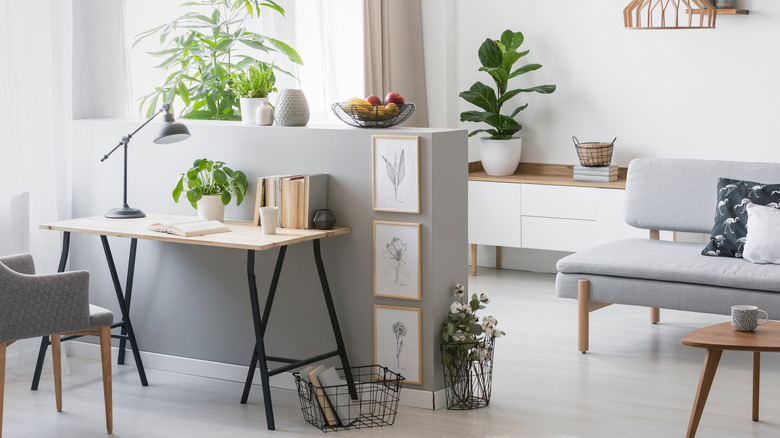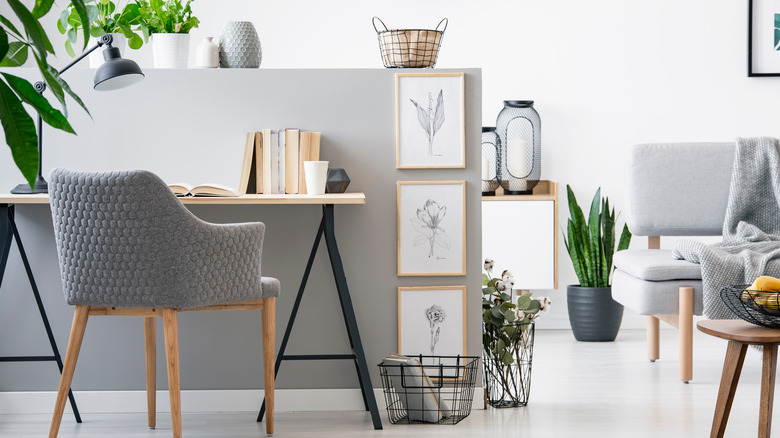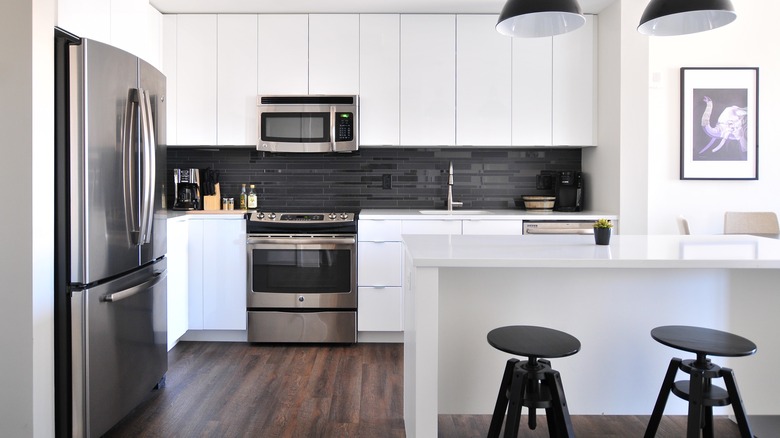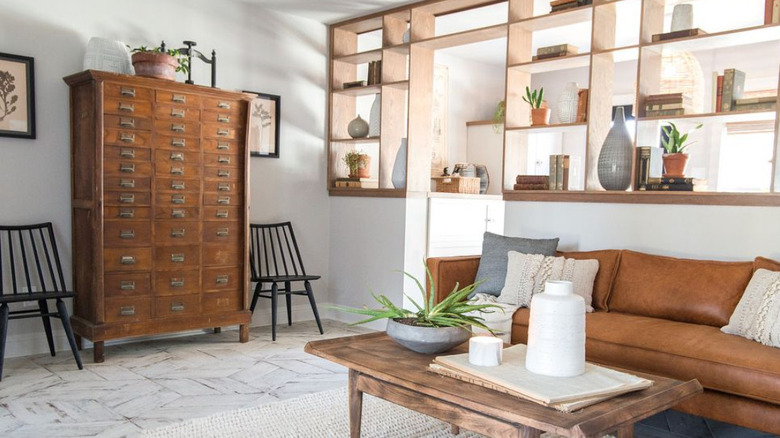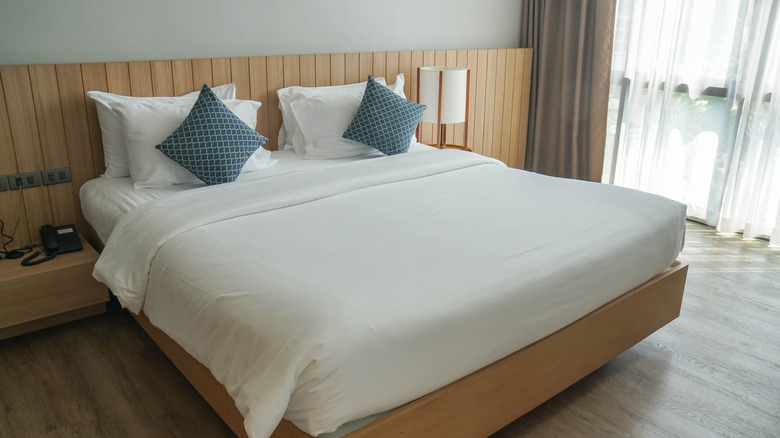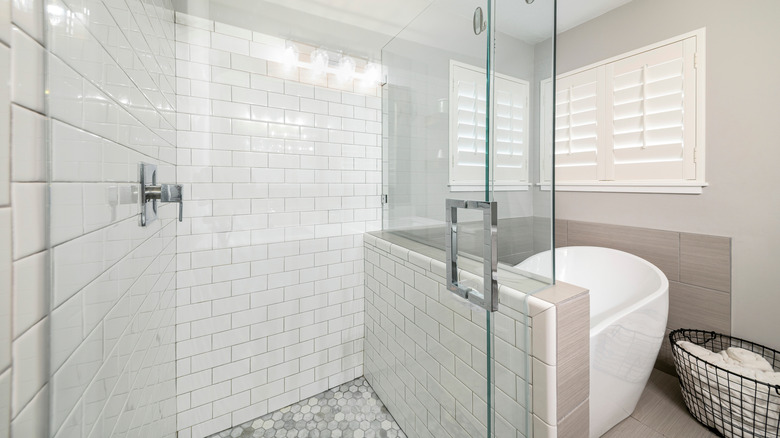What Is A Pony Wall And What Is It Used For?
Although there isn't much known about the creation of pony walls, according to Architecture Lab, the shortened walls are believed to have been created sometime in the late 19th century by Walter Clydell. A farmer from Nebraska, Clydell went about crafting what is now known as the pony wall after wanting shorter walls in his horse stable to make it easier for him and his animals to see in and out of the stalls.
And although the usage of Clydell's creation began to spread throughout the farming community, it wasn't until the 1950s and 60s that the pony wall began showing up in residential and commercial properties. Popularized along with retro and mid-century decor and architectural design elements, pony walls allowed homeowners to have more open concept layouts in their homes while still keeping individual rooms defined.
Now, roughly 150 years since Clydell first built the shortened wall, pony walls can have multiple uses both inside and outside of the home and can be found in a number of places within the home, although their abundance in a home seems to be related to the house's age. And while there has been a recent decline in the popularity of pony walls in interior design, these walls are normally found near kitchens, open multi-purpose spaces, bathrooms, and stairwells, and in most cases, they act as a room divider.
Pony walls vs. other wall types
As for how pony walls stack up against other interior walls, they're generally three to 4 feet tall (via MYMOVE) but can vary a bit in width depending on the wall's intended use. If it's being used as a divider or along a stairwell, chances are the wall has the same thickness as most interior walls, which are about 4½ inches wide. However, because pony walls are designed to be shorter, they're not the same height as standard interior walls, which range from 8 to 10 feet tall in most homes, per Home Inspection Insider.
And while pony walls clearly differ from standard interior walls, there are other types of partial walls within the home that pony walls are often confused with. One type, known as the knee wall, tends to be used interchangeably with pony walls due to their similarities in height. However, the two wall types are very different from one another based on their versatility and purpose within the home.
Overall, pony walls are generally decorative walls that can be found throughout the home and likely aren't load-bearing. Knee walls, on the other hand, are normally located in the attic of a home, where they provide support to the roof rafters. Along with stabilizing a house, knee walls can also help maintain a comfortable living atmosphere as pockets of space are created behind the walls when they're installed and can be filled with installation, according to Attic Guys.
Kitchens
A versatile room for pony walls, there are a number of ways to go about using these types of walls in your kitchen, but one of the most popular uses for them is in the form of breakfast bars, according to Architecture Lab. Great for any size kitchen, breakfast bars are not only a place to eat but a place to work as well. And despite their name, breakfast bars can be used for just about any meal, any time of the day, and are also the perfect place to showcase flowers and plants as well.
Along with using your pony wall as a breakfast bar, in kitchens with half walls, as well as additional room for a breakfast nook, banquette seating may just be your best option. Often seen in restaurants, banquettes are designed to specifically fit a space and its walls, likely appearing in the form of booths, benches, and chairs. As for how they work with pony walls, depending on your breakfast nook's size, your pony wall can serve as one of the banquette's support walls.
Another great use for pony walls in the kitchen is using them as bookcases (via Kelly Hogan). Whether they're built-in or DIY'ed, pony walls with shelves can provide extra storage, which can be key in the kitchen and add another layer of personalization to the room. So no matter what you use these shortened walls for, there's no denying that they have lots of potential in the kitchen.
Multi-purpose spaces
While multi-purpose rooms can be just about anything, in most cases, they serve as family rooms and living rooms. And although they may seem great for relaxing and entertaining at first, these rooms oftentimes don't offer much when it comes to storage. However, because family rooms and living rooms tend to be located near the kitchen and entryways in a home, the chance of finding a pony wall in one of these spaces is fairly likely.
Similar to these rooms, pony walls also have limited functionality and mainly serve as room dividers that direct the foot traffic in a home. One way to go about increasing the wall's functionality is by adding open shelving above your pony wall. This solution has been replicated by DIYers like The Handcrafted Haven and has also been featured in an episode of HGTV's "Fixer Upper," during which Chip and Joanna Gaines renovated a 1950s bungalow and included multi-purpose space intended as a sitting room, a laundry room, and a home office.
If you aren't in need of more storage space in your multi-purpose rooms but want to customize your pony wall some more, there are other DIYers like Lisa from Shine Your Light who have the perfect solution for you. The veteran blogger updated her builder's grade pony wall by replacing the original baseboard, adding new trim and board and batten woodworking to the wall, and boxing in its column so that it had a more modern, craftsman appearance.
Bedrooms
Considering that pony walls are traditionally used as room dividers, their role in the home takes on a whole new meaning when it comes to bedrooms. A somewhat unexpected room to find these walls in, they aren't normally included in bedrooms, but in some cases nowadays, the walls may be a versatile addition to a room that is dedicated to resting and relaxation. And depending on the room's layout and dimensions, pony walls can help ground the space and increase its functionality.
There are a few ways to utilize pony walls in your bedroom, but one of the best ways to maximize the room's square footage is by using one of these walls as your headboard. Based on the wall's location in your bedroom, this will allow you to dictate what the various areas of your bedroom can be used for. It can also allow you to further customize your room as you can also opt to build the pony wall and the bed frame yourself.
And while it may seem odd to have a pony wall in the middle of your bedroom at first, just remember that the wall serves more than one purpose based on your needs so that it can double as a makeshift office, a reading nook, an open closet, or a combination of the three (via Kelly Hogan). Even though pony walls may seem a bit outdated and can be annoying to deal with, they are truly versatile additions to any home.
Bathrooms
Along with finding pony walls near staircases and kitchens, they're most commonly found in bathrooms as they can add additional privacy to the room while still maintaining an airy, open concept feel. In particular, pony walls are often used to block off certain areas of the bathroom, including the toilet and the shower, and tend to be found in larger bathrooms like master bathrooms, according to Architecture Lab.
In terms of how they're used alongside toilets, pony walls can act as a barrier between the toilet and other parts of the bathroom, whether it's the vanity, the shower, or the tub. A great substitute for private water closets in bathrooms that are lacking in square footage, pony walls can also offer homeowners extra storage options as they provide more wall space to hang towel racks and can be customized with built-in shelves and niches too.
Overall though, pony walls located in the bathroom are generally covered in either drywall or tile, but in some cases can be a mix of the two. For showers, the wall is normally tiled and can act as a splash guard and a support system for other parts of the shower like glass walls or bench seating, similar to a banquette in a kitchen (via MYMOVE). As for tubs, pony walls are generally tiled depending on the type of tub and its height, as well as whether or not the tub is included in a wet room with a shower.
